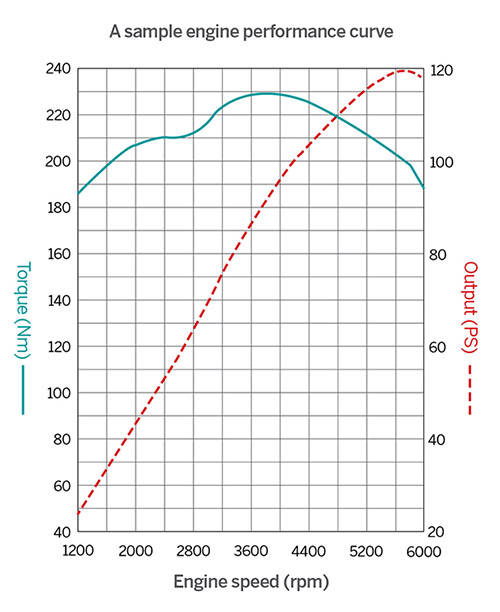Sometimes people say "The engine of Car A has a higher torque than Car B with both having the same horsepower" My question is : if both cars are equal in horsepower can't we just avail this equal horsepower by gearsets and get equal torques for both cars by reducing speeds for the two cars?And thus a truck and a car will have equal torques just by gear sets "If" they have the same horsepower . Why is all that struggle about The car Torque number when the key is the horsepower that can give any speed or torque by having gearsets?
3 Answers
Although I agree with others in that the reason in not technical (but rather advertising - I guess the suffix power in horsepower resonates well with hormone driven masculinity), I will try to explain some of the subtle differences I perceive.
Below is a sample engine performance curve. With green/blue solid line is the torque, while with dashed red line is the horsepower. On the x axis is the rpm.
Immediately. is is evident that horsepower tends to change more than the torque. This is a reflected in the equation of :
$$P = M \cdot \omega$$
where:
- P is the horsepower
- M is the torque
- $\omega$ is the angular velocity (which is proportional to the rpm $\omega = {2\pi \cdot n\over 60}$
Having a flat torque curve is considered a good characteristic. That would yield an almost straight horsepower curve. In both cases (horsepower and torque) the value that is reported is the maximum value of the curve.
E.g.: for torque in the example above the torque would be 230Nm at 3700 rpm, and the power would be 120 PS at 5500 rpm.
I agree that the most useful number for everyday driving would be the torque, because it is at a range that most cars usually work. The only case that max power is reached is when accelerating hard and hitting over 5000 rpm in which case the engine is stressed and probably borderline abused. So torque would be a more useful everyday metric.
However, in general , maximum horsepower and maximum torque give only a snapshot of the engine performance at different rpms. If you really need to understand your engine and you need to optimise the driving attitude, then you'd need to have access to the full mapping of the torque/power curve.
For example ,things can become more complicated because engines can be tweaked to yield different torque responses (see below).
 figure source :Car Throttle
figure source :Car Throttle
All those engines above have the same peak horsepower, but completely different torques. Driving those cars would give completely different sensations. It is interesting to note that the top speed would be the same, however accelerating would be different.
We know torque multiplied by RPM equals power at a certain RPM. Different engines have their maximum torque at different RPMs. Otherwise, an engine could produce more power at higher RPMs even if at a lesser torque.
Engines' torque is designed early on to be optimal for the job the engine will do. For a truck, this is closer to low RPM to give it the power to tow heavy loads, even if slowly, up the hill. A sedan would benefit from max torque at mid RPM range, a race car perhaps closer to high RPM to give it the power to make a pass at high speeds. A Piston engine for an airplane needs steady maximum torque stretched over a wide range of RPMs.
High torque has a cost, fuel consumption, and extra stress on the engine, so it has to be utilized wisely.
All these of course are modified by the transmission. The lower the gear the higher torque.
A longer stroke gives more torque for the same displacement. The stroke is like a lever arm. Simplified, the torque is the pressure in the cylinder times the crankshaft throw (stroke). My first car had high torque, 1941 Cadillac; 346 cu.in, 150 Hp, but 4.5" stroke (3.5 bore) gave it 350 ft,lb. torque. I can't find the torque on the net and I through away my Chiltons Motor manual years ago so I can't document the torque. Maybe someone will be able to find the torque and prove me wrong.

Why is all that struggle about The car Torque number?... it is advertising to sell more cars ... the advertised torque values are probably unattainable by the average driver $\endgroup$